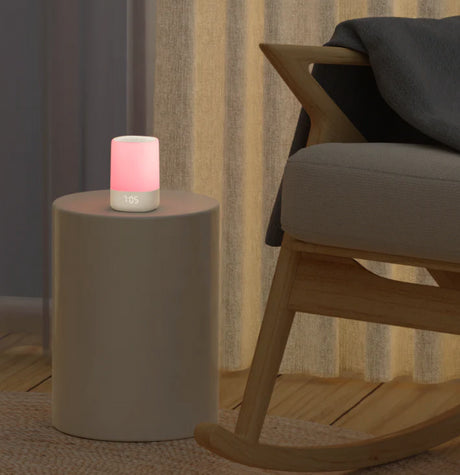We're big into sleep (just take a look out or schedule chock full of Study classes that help you relax into a perfect night's rest). But today, we're delving into the science behind sleep and how the Nanit Sound and Light device is designed to promote healthier sleep patterns for your baby. This innovative device offers a variety of sounds and light settings, all meticulously tailored to support your baby's sleep cycle.
But what's the research behind these specific settings? What scientific theories and studies inform these choices? Let's explore the evidence supporting the use of white noise and specific light exposure in promoting better sleep, and how these principles have been incorporated into the Nanit Sound and Light device.
We'll also discuss how this device can support different stages of a baby's sleep cycle, its impact on babies with sleep difficulties, and how it encourages healthy sleep habits rather than fostering dependency. Let's get into the fascinating world of sleep science and discover how the Nanit Sound and Light device can help your little one (and you!) get a better night's sleep. Here, we chat with Nanit's research team.
Can you discuss the research behind the particular sounds and light settings included in the device?
Several studies have shown that babies sleeping with white noise are calmed and fall asleep faster, wake less, and are less likely to resist bedtime as they become toddlers. The Nanit Sound and Light comes with several different sounds so that you can choose what works best for your baby. Light exposure at night should be minimal to support the production of hormones like melatonin, that promote optimal circadian rhythms and sleep4. As children get older, different colored lights can become cues for the bedtime routine or wake up time or quiet playtime, depending on the needs of the family.
How does the Nanit Sound and Light device specifically support the different stages of a baby's sleep cycle, from drowsiness to deep sleep?
Using white noise can help children to fall asleep because it functions as a stimulus control, which is a technical term to say that white noise becomes a cue for sleep. In addition, white noise can “mask” the presence of other sounds that would otherwise disturb sleep, allowing children to transition from one state to another without interruptions. Because our auditory system remains active during sleep, we respond to signals perceived as relevant. Using white noise will make the auditory system perceive other sounds as less loud, decreasing the chances of noise-induced sleep disturbances. White noise has been found to be helpful even to settle colicky babies
In your studies and through user feedback, what have you found to be the impact of the device's sound and light features on babies who have traditionally had difficulties getting a good night's sleep?
Our internal data show that babies who sleep with white noise sleep on average an hour longer per night and their longest stretch of sleep is two hours longer than babies who sleep without white noise. In addition, most parents feel comfortable using white noise even when they share a room with their baby. Actually, they even enjoy the soothing effect! White noise will not fix all your troubles with your baby’s sleep in one day, but if used consistently from early on, together with other sleep hygiene practices, it can be a great ally.
Parents often worry about dependency on sleep aids. How does the Nanit Sound and Light device help to encourage healthy sleep habits rather than fostering dependency?
Everyone has sleep associations and we want to encourage positive sleep associations in children - which are either things they can do for themselves or things that will always be there for them. When children have positive sleep associations it helps them fall asleep faster and stay asleep longer. For example, sucking a finger or twirling hair are things that a baby can do for themselves (when
they are at an age where they are capable of self-soothing) and can be positive sleep associations. White noise or a firm crib mattress are part of their environment that also become positive sleep associations because they are things you can always provide to your baby.
How does the Nanit Sound and Light device integrate with the broader Nanit ecosystem, like the Nanit Breathing Wear and Nanit app?
Nanit’s mission is to empower parents. Until now, the Nanit camera helped parents to track and understand better their baby’s sleep. Now with Sound and Light the Nanit ecosystem provides parents with a great partner that can help them promote healthy sleep habits and routines. And all of these tools are backed up by a lot of research and amazing researchers, which gives Nanit parents peace
of mind that they are in good hands!



